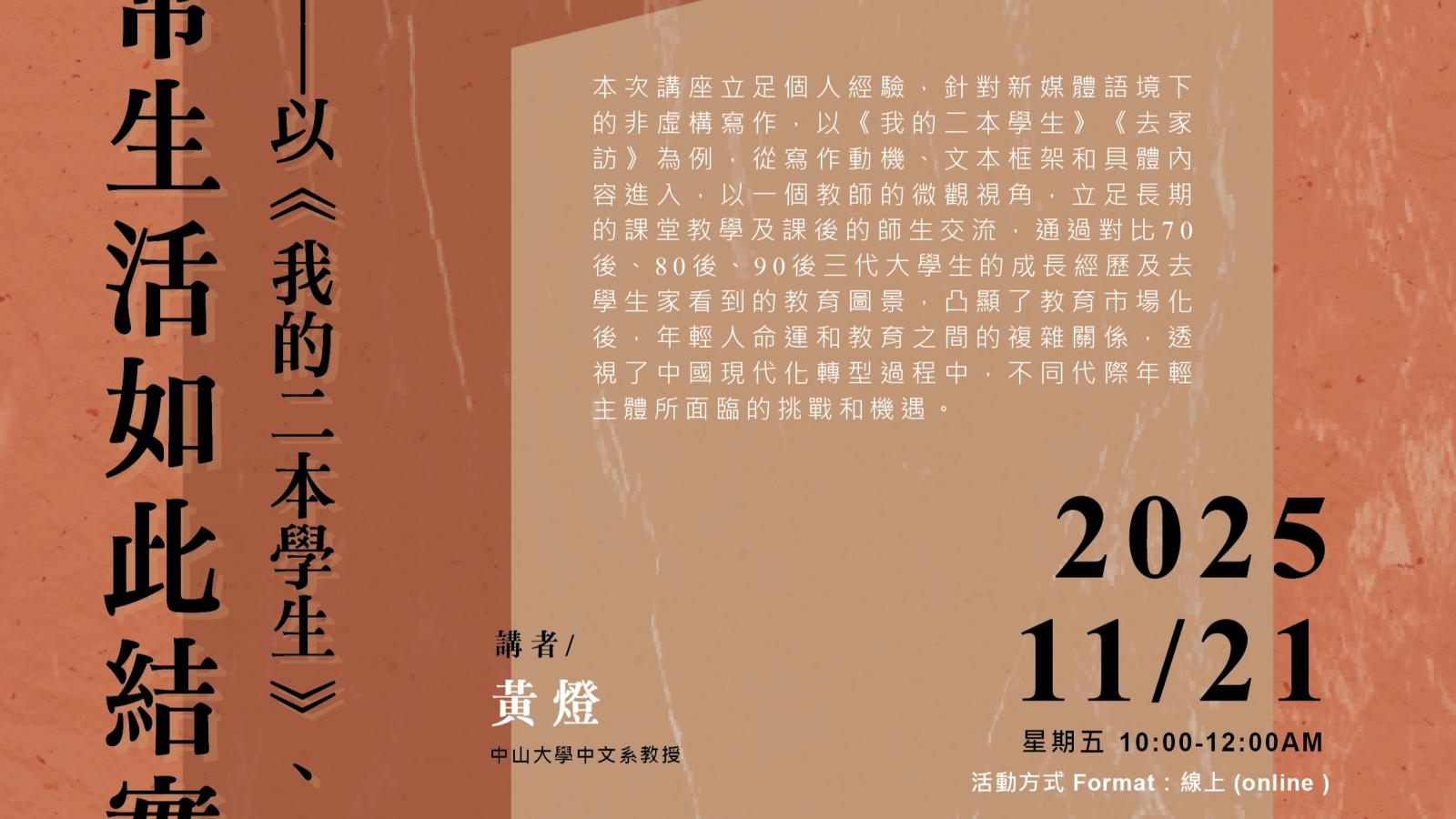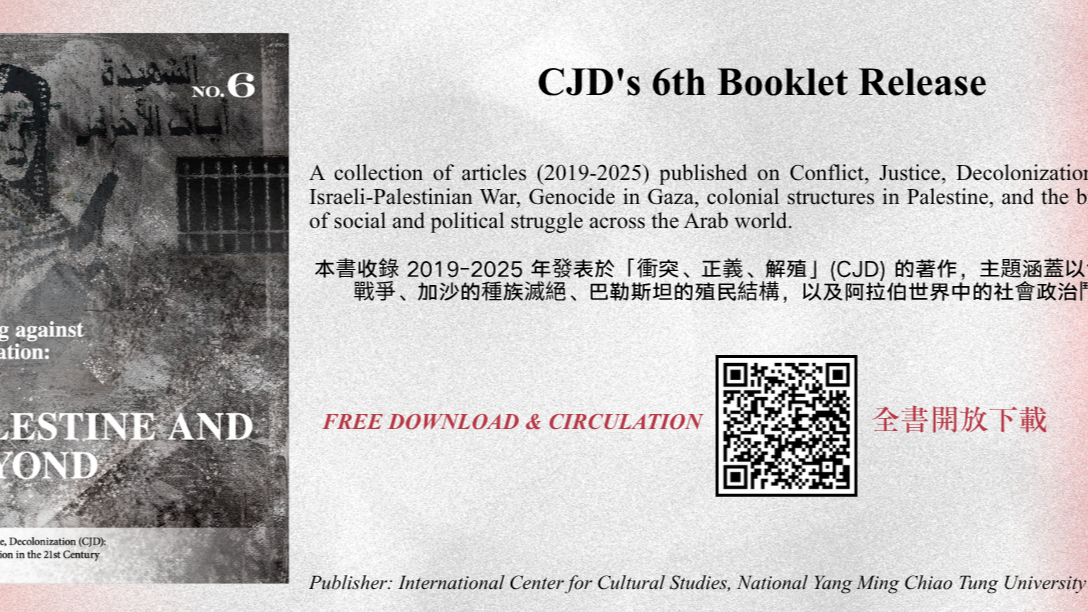

Activity Report: Sinophobia in the Rise of China - Session 3
2022-11-07
活動名稱:中國崛起下的中國恐懼
Event Title: Sinophobia in the Rise of China
Session three - Cultural Politics of Place in the Borderlands of North and Central Asia
日期Date:111.10.10
時間 Time:9:00-18:00
地點 Venue:陽明交通大學人社三館 R103 室 R103 HA Building 3, NYCU, 1001 University Road, Hsinchu, Taiwan 300 (線上 zoom meeting 與現場同步進行)
主辦單位:國立陽明交通大學文化研究國際中心、台聯大文化研究國際中心、台聯大系統亞際文化研究國際碩士學位學程、國立陽明交通大學社會與文化研究所
指導單位:國立陽明交通大學研究發展處
經費來源:教育部高等教育深耕計畫
活動鏈接Link:International Center for Cultural Studies - 文化研究國際中心 (nycu.edu.tw)
Author: Monika Verma (Ph.D. candidate, NYCU, Taiwan; contact: moniletit@gmail.com)
Table of Content
Introduction
Sergei Ivanov, Russian Academy of Sciences, Far Eastern Branch (Vladivostok)
Territory and Sinophobia/philia: Chinese Presence in the Russian Far East in Official Discourse and Popular Geopolitics
Sayana Namsaraeva, University of Cambridge (UK), Mongolia & Inner Asia Studies Unit (MIASU)
"Poisoned Waters and Tamed Birds": Historical and Present-Day Dehumanizing and Super- humanizing Sinophobic Narratives from Russian Siberia
Azim Malikov, Palacky University (Czech Republic), Sinophone Borderlands Project Uzbek Perspectives on the growth of China’s Influence in the Region
Discussion
Introduction
This session discusses geopolitical and anthropological cases based on cases from the Russian Far East, Russian Siberia, and Central Asian Uzbekistan, where Sinophobic views have their own reginal characteristics. The first case, in particular, illustrates the diverse perspectives of Sinophobia/Philia present in the Russian Far East, where discources that 'China as a friend' and 'China as a dystopia' are coexisting in public opinion. Continuing on the topic of Sinophobia in Northern Asia, the second presenter examines several historical cases of the Sinophobic narratives dated back as early as the 18th century, and how they evolved and have been reshaped at present. Taking the case of Uzbekistan, the third presenter discusses the Uzbek perspective on China's growing influence in Central Asia. The talks were presented at a workshop held at HA Building 3, NYCU, and chaired by Prof. Yuan Horng Chu.
Sergei Ivanov, Russian Academy of Sciences, Far Eastern Branch (Vladivostok)
Territory and Sinophobia/philia: Chinese Presence in the Russian Far East in Official Discourse and Popular Geopolitics
.png)
-02.png)
In the third session of this event, "Sinophobia in the Rise of China," Sergei Ivanov presented a case study on the Russian Far East as part of the discussion, taking into consideration the different aspects of Sinophobia/philia. In his preliminary remarks, the speaker acknowledged that Sinophobia has become a more geopolitical phenomenon and that it has moved from being associated with 'Asia' or the 'Chinese' to being associated with a specific state or country - China. In the contemporary Sinophobic environment, we can see the concept of Sinophobia differently. We can see it, for example, as an attempt to imagine the future and even create a dystopia through geopolitical constructs and common stereotypes of the Chinese people. It is essential to see that, he argued, Sinophobia does not only function as fiction but can also be used as a tool for concretizing specific narratives of dystopia, provoking specific actions against internal enemies and acting directly against "China" or "the Chinese," thus rendering them undesirable and dangerous. There are many ways in which the increase in Sinophobic narratives can be observed. Still, the most apparent means are the propaganda in the media and the protest and resistance actions. Russia's public opinion, he added, encompasses a combination of perceptions of China as a friend and China as a dystopia.
The researcher, in his research, draws on recent studies of the future, which provide a new perspective on the fear of China and does not undermine the importance of the past experiences that led to this fear. In this way, he proposes that everyday life be viewed as a function of future orientations rather than simply passively reproducing the past, which shapes and coordinates social action in the present rather than passively reproducing it. By taking a step further, he suggested, Sinophobia can be conceptualized as "an act of futuring" where images of the future are conceived, constructed, and distributed, enacting relationships between the past, present, and future. As such, Sinophobia goes beyond imagining, for it can also have some practical, present-day effects that can cause specific actions to be taken.
Furthermore, he discusses the symbolic significance of the Far East and Siberia for Russia's future, demonstrating how strongly the Far East is woven into the discourse of Russian greatpowerness and how this is related to the Far East. The speaker attempts to analyze the official discourse, which portrays a positive image of China, and persists that this Sinophile image is misleading because it does not provide a clear picture of Russia's future when China is going to be the key player and role model rather than Europe. Afterward, he went on to describe the image of China that can be found in social media, which frequently appears as a representation of nationalist or conservative views that are Sinophobic, so he depicted a Chinese dystopia of the Far East that he called for concrete action to prevent from becoming a reality.
His concluding remarks are notable in that he mentions that the cause of Sinophobia, at least in Russia, is not only a manipulation of the knowledge of the past and present but is also a result of a relationship between social and individual orientations toward the future. This undeniable potential of the Chinese people, coupled with the perception that they are capable strategists and capable of calculating the future, makes Sinophobia an ideal breeding ground. It is essential to understand that Sinophobia, he believes, goes beyond the passive expectation of danger and instead is a call to action to prevent a Chinese dystopia in the Russian Far East from ever happening.
Sayana Namsaraeva, University of Cambridge (UK), Mongolia & Inner Asia Studies Unit (MIASU)
"Poisoned Waters and Tamed Birds": Historical and Present-Day Dehumanizing and Super- humanizing Sinophobic Narratives from Russian Siberia
%2C%20Mongolia%20_%20Inner%20Asia%20Studies%20Unit_.png)
%2C%20Mongolia%20_%20Inner%20Asia%20Studies%20Unit-02.png)
A unique research approach to Sinophobic sentiments was demonstrated by Sayana Namsaraeva, whose presentation was based on analysis of the historical and present day cases from Russian Siberia in the longue duree perspective. Due to the geographical proximity of Russian Siberia to China and more than three hundred years of direct encounters along the extended Sino-Russian border, she argues that the Sinophobic sentiments in this part of the world can be considered as one of the earliest in European modern history. She introduced a historic stereotype, which firstly originated among Russian colonists about the time of signing the Treaty of Kyachta (1727), when Russian officials in atmosphere of distrust to their Manchu counterparts suspected them in possibility of poisoning the Selenga and the Chikoi rivers, which flow from the Chinese side of the border into Russia, to expel Russian from their newly conquested Siberian territories. Further, she provided insight about how this Sinophobic fear evolved during the 19th century when residents of Kyachta accused Chinese traders in using 'black magic' to grow vegetables in cold seasons. They simply were not aware of that Chinese traders built green houses behind the wall of Maimaicheng to grow vegetables all year around. Later in the 2000s this narrative developed into another fear against Chinese farmers, that they were growing ‘poisoned’ vegetables by exessivly using toxic fertilisers.
Final part of her presentation brought our attention to one of the most recent Sinophobic narratives from the Lake Baikal, where the locals suspected Chinese in manipulating invasive sea ravens (also known by a variety of other names, such as 'cormorant' and Corvus Marinus) in attempts to expel local birds species and local fishing communities from the lake. Global warmening allowed cormorants to migrate in great numbers further to the north and their aggressive fishing methods exsausted limited fish stock in the lake, leaving local seguls on the brink of extinction. To analyse this case, Sayana uses a concept of the ‘Anthropological machine’ by Agamben (2002), which in the context of the historical "Yellow Peril," explains dehumanizing of particular groups of people, such as Chinese or Asians. She argued that the ‘anthropological machines’ might work not only to dehumanise people - for example, to portrays the Chinese allegorically as invasive sea ravens in the fight for the natural resources, but it can also work to 'superhumanize' certain social individuals or groups to endue them with supernatural abilities and power to control the nature. In this case this superhumanizing narrative attempts to depict modern rise of China not only as political and economica superpower, but also as a cosmopolitical superpower to make Sinophobic fears more complex and contradictive.
Azim Malikov, Palacky University (Czech Republic), Sinophone Borderlands Project Uzbek Perspectives on the growth of China’s Influence in the Region
%20(3).png)
-02.png)
During Azim Malikov's talk, he brings to light Uzbekistan's view on China's growing influence in the region and how it affects Uzbekistan's position in the area. Several points were made during his presentation regarding the cultural exchange between the Uzbekistani and Chinese people associated with notions of knowledge and high culture and its positive mythologized image that was more commonly perceived in Uzbekistan. Thus, if we compare, he stated, Uzbekistan to Kazakhstan and Kyrgyzstan, we can see that there are no such intense instances of Sinophobic discourses in Uzbekistan as are seen in Kazakhstan and Kyrgyzstan.
It has been pointed out in the speaker's presentation that there has been little research on how people in Uzbekistan perceive China and Sinophobia in the region and that these issues are relatively understudied. As China has grown economically in the 21st century, it has been experiencing significant economic growth, and its influence over Central Asia has risen. However, the strengthening of China's influence in Central Asia has been accompanied by a form of Sinophobia, a phenomenon that has several causes and manifestations. For instance - It has been reported that he added the issue of the introduction of the Chinese language in some kindergartens. Consequently, both Uzbek-speaking and Russian-speaking citizens of Uzbekistan responded negatively to these initiatives on social media networks as a result of these initiatives. He probably argued that strengthening ties between the Uzbek people and the Chinese would increase the number of Chinese migrants in Uzbekistan, which will, in turn, contribute to the escalation of anti-Chinese sentiments within the country, given the economic conditions there.
Among the reasons for the strengthening of Sinophobia, it has been argued that the Uighur community may play an essential role since Uzbeks are very similar to Uighurs culturally and linguistically. There are parts of Central Asia where Uzbeks and Uighurs are considered to be the same ethnic group.
Following the analysis of all the above-mentioned points, he made a concluding statement stating that risk-based Sinophobia plays a more significant role in decisions related to China than group-based Sinophobia.
Discussion
After three exciting presentations, Prof. Chu returns to the discussion of topological questions concerning 'Chineseness,' which is very relevant to inner Asia, and suggests that we should distinguish between the state of China and the people of China. The discussion was further deepened by Mukaddes Altunbas, who raised questions regarding the ethnographic perspective on the issue of Uighurs. She was more interested in how people in Uzbekistan understood this issue of Uighurs and what their opinions were. In answer to her question, Azim Malikov explained that the Uighur issue had played a very significant role in the emergence of Sinophobia as a phenomenon in Uzbekistan. In recent years, the Uighur issue has been a highlight of the some sections of society in Uzbekistan, especially since the new president's election in 2016. Before that, the Uighur issue had not been discussed in social media, including Facebook, or on forums. It had been addressed solely by some political opposition abroad.
Further, Fang Long Shih also contributed to the discussion by raising questions about the various groups of Chinese people, such as Huaren, Hwaren, the Chinese diaspora, and other groups of Chinese people in general. In their research, she questioned, does Sinophobia make a difference between Huaren/Hwaren and Zhongguoren as they research Sinophobia? During the discussion, Sayana Namsaraeva answered the question. She noted that in Eastern Siberia, the category of Zhongguo ren has unfortunately had a dominating status over Huaren/Hwaren due to long-lasting historical perceptions of the category. Since the definition of various Chinese types appeared later, it was easier for people to see Hwaren and Zhongguaren.
Moreover, other speakers also find the situation to be similar in their region as well. Taking some points from Prof. Alain Brossat's paper, Prof Chu again discusses that Sinophobia is a global phenomenon affecting all ethnic categories of Chinese people. In the long run, Sinophobia will have a negative impact on all Asian Chinese.
.png)

近期新聞 Recent News

Report|Conceptualizing Digital Governance in the Age of Semiconductors: A Critical Review of Keywords and Concepts
2025-12-03
more

New Publication | Writing against Occupation: Palestine and Beyond (CJD Booklet No.6)
2025-11-12
more